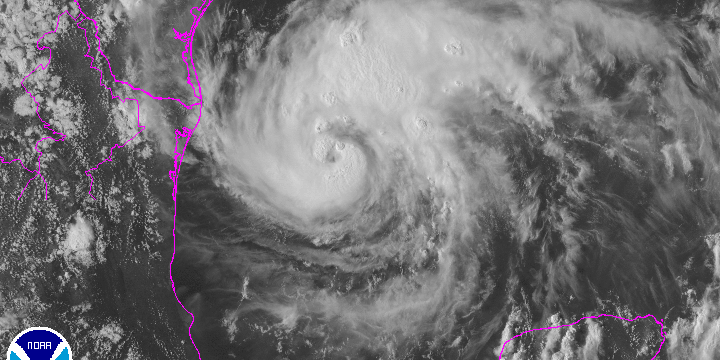As Hurricane Harvey grows in strength to a Category 2 storm and approaches Texas, local officials have a message to those considering riding out the storm: “Get out now.”
The first major hurricane to hit Texas in 12 years, labeled by forecasters as a “life-threatening storm,” could bring up to three feet of rain, 125 mph winds and 12-foot storm surges. “If it’s 10 feet of water, there’s a good chance you will lose electricity,” Corpus Christi Mayor Joe McComb said. “So you’ll be on the Island with no [air-conditioning], no water, no electricity. We recommend in the strongest terms that you need to get out now or get to higher ground.”
Landfall was predicted for late Friday or early Saturday between Port O’Connor and Matagorda Bay, a 30-mile stretch of coastline about 70 miles northeast of Corpus Christi. Harvey has been fueled by warm Gulf of Mexico waters.
To put the hurricane’s strength in perspective, superstorm Sandy, which wasn’t formally called a major hurricane and still devastated New York and New Jersey in 2012, didn’t have the high winds like Hurricane Harvey and lost tropical status by the time it hit land. “We’re forecasting continuing intensification right up until landfall,” National Hurricane Center spokesman Dennis Feltgen said.
As of late Thursday afternoon, Harvey was roughly 305 miles southeast of Corpus Christi, making its way north-northwest at about 10 m.p.h, with sustained winds clocked at 85 mph. Texas Gov. Greg Abbott, who has activated about 700 National Guard members ahead of Hurricane Harvey’s arrival, said in a statement that President Trump called him to pledge all available federal resources to assist in preparation, as well as rescue and recovery efforts. Abbott said he assured Trump that Texas was working hand-in-hand with local and federal partners.
“FEMA stands ready to support state, local and tribal officials as they prepare for Hurricane Harvey,” Brock Long of the Federal Emergency Management Agency said in a statement. “I encourage residents who will be affected to follow directions from their local officials. Know your threats, heed the warnings, and if you’re in the path of the storm, ensure your family is prepared for possible prolonged disruptions to normal services.” FEMA established an Incident Support Base at Randolph Auxiliary Airfield near Seguin, Texas, filled with supplies such as water, meals, blankets and other resources to be available to potentially affected residents.
White House spokeswoman Sarah Sanders said President Trump will be briefed throughout the hurricane’s progress. Officials are concerned with the amount of people that are evacuating compared to previous storms, as Abbott urged people to “heed warnings and evacuate as soon as possible,” while on Houston television station KPRC. “A lot of people are taking this storm for granted thinking it may not pose much of a danger to them,” Abbott told KPRC.
Evacuations have been ordered for the counties along the Texas coast, from Corpus Christi to the western end of Galveston Island, and in four of those counties officials warned rescue for people who stayed behind is not guaranteed. Harvey’s effect would be broad. The hurricane center said storm surges as much as 3 feet could be expected as far north as Morgan City, Louisiana, some 400 miles away from the anticipated landfall.
And once it comes ashore, the storm is expected to stall, dumping copious amounts of rain for days in areas like flood-prone Houston, the nation’s fourth most-populous city, and San Antonio. State transportation officials were considering when to turn all evacuation routes from coastal areas into one-way traffic arteries headed inland.
John Barton, a former deputy executive director of the Texas Department of Transportation, predicted state officials will do this before the storm hits, but said timing and determining where to use it are the key factors. Storms change paths and if contraflow starts too early, supplies such as extra gasoline needed to support impacted areas can’t get in, he said.
Harvey would be the first major hurricane to strike Texas since Ike in September 2008, which brought 110 mph winds, as well as $22 billion in damage. It would be the first big storm along the middle Texas coast since Hurricane Claudette in 2003 caused $180 million in damage. It’s taking aim at the same vicinity as Hurricane Carla, the largest Texas hurricane on record. Carla came ashore in 1961 with wind gusts estimated at 175 mph and inflicted more than $300 million in damage. The storm killed 34 people and forced about 250,000 people to evacuate.
In Houston, one of the nation’s most flood-prone cities, Bill Pennington prepared his one-story home for what he expected would be its third invasion of floodwaters in as many years and the fifth since 1983. “We know how to handle it. We’ll handle it again,” Pennington said he told his nervous 9-year-old son. People are stocking up the shelves with essentials as they prepare for Harvey, visiting home improvement stores and supermarkets. Alex Garcia bought bottled water, bread and other basics in the Houston suburb of Sugar Land after dropping his daughter off at college. He said grocery items were likely more available in Houston than back home in Corpus Christi, where Garcia, a beer distributor salesman, said stores were “crazy.”
“We’ll be selling lots of beer,” he laughed.
In Galveston, where a 1900 hurricane went down as the worst in U.S. history, City Manager Brian Maxwell said he was anticipating street flooding and higher-than-normal tides. “Obviously being on an island, everybody around here is kind of used to it.”










